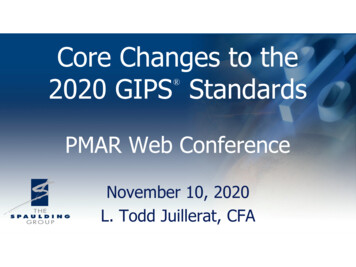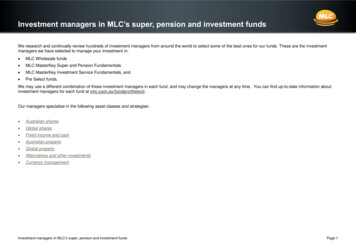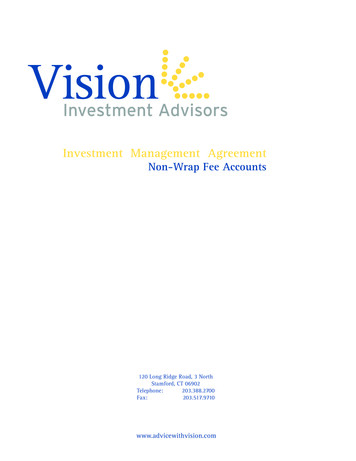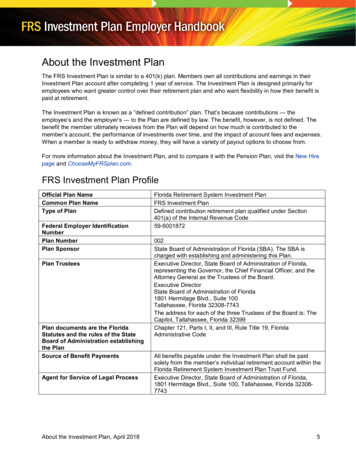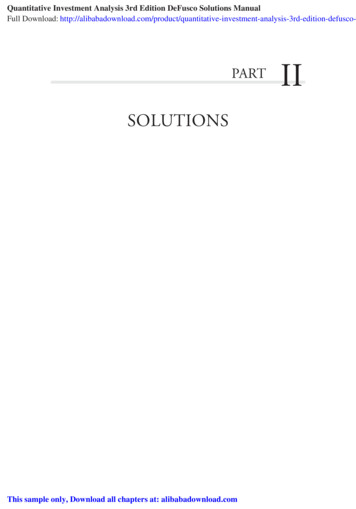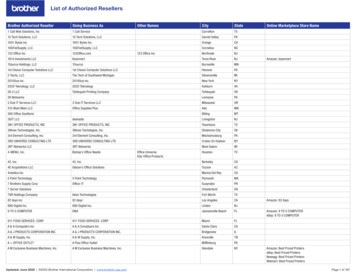
Transcription
GLOBAL INVESTMENTPERFORMANCESTANDARDS (GIPS )FOR ASSET OWNERS 2020
GLOBAL INVESTMENTPERFORMANCE STANDARDS (GIPS )FOR ASSET OWNERS2020
GIPS is a registered trademark owned by CFA Institute. 2019 CFA Institute. All rights reserved.No part of this publication may be reproduced, stored in a retrieval system, or transmitted, in anyform or by any means, electronic, mechanical, photocopying, recording, or otherwise, without theprior written permission of the copyright holder.This publication is designed to provide accurate and authoritative information in regard tothe subject matter covered. It is sold with the understanding that the publisher is not engagedin rendering legal, accounting, or other professional service. If legal advice or other expertassistance is required, the services of a competent professional should be sought.ISBN 978-1-942713-72-2
CONTENTSPrefacevIntroductionviiEffective Datexvi21. Fundamentals of Compliance122. Input Data and Calculation Methodology523. Total Fund and Composite Maintenance1224. Total Fund and Composite Time-Weighted Return Report1325. Additional Composite Money-Weighted Return Report2226. GIPS Advertising Guidelines30Glossary35Appendix A: Sample Total Fund GIPS Asset Owner Reports45Appendix B: Sample Composite GIPS Asset Owner Reports57Appendix C: Sample GIPS Advertisement61Appendix D: Sample List of Total Fund and Composite Descriptions63www.cfainstitute.org 2019 CFA Institute. All rights reserved. iii
PREFACECFA Institute is a global not-for-profit association of investment professionals with the mission ofleading the investment profession globally by setting the highest standards of ethics, education,and professional excellence. CFA Institute has a longstanding history of commitment to establishing and supporting the Global Investment Performance Standards (GIPS ). The GIPS standardsare ethical standards for calculating and presenting investment performance based on the principles of fair representation and full disclosure.The GIPS standards are the recognized standard for calculating and presenting investment performance around the world. Compliance with the GIPS standards has become a firm’s “passport”to market investment management services globally. Asset owners that comply demonstrate acommitment to adhering to global best practices. As of June 2019, CFA Institute has partneredwith organizations in more than 40 countries and regions that contribute to the development andpromotion of the GIPS standards.History In 1995, CFA Institute, formerly known as the Association for Investment Management andResearch (AIMR), sponsored and funded the Global Investment Performance StandardsCommittee to develop global standards for calculating and presenting investment performance, based on the existing AIMR Performance Presentation Standards (AIMR-PPS ). The first Global Investment Performance Standards were published in April 1999. That year,the Global Investment Performance Standards Committee was replaced by the InvestmentPerformance Council (IPC) to further develop and promote the GIPS standards. The development of the GIPS standards was a global industry initiative with participation from individualsand organizations from more than 15 countries. The IPC was charged with developing provisions for other asset classes (e.g., real estate andprivate equity) and addressing other performance-related issues (e.g., fees and advertising)to broaden the scope and applicability of the GIPS standards. The second edition of the GIPSstandards, published in February 2005, accomplished this goal. With the 2005 edition release and the growing adoption and expansion of the GIPS standards,the IPC decided to move to a single global investment performance standard that would eliminate the need for local variations of the GIPS standards. All country-specific performancestandards converged with the GIPS standards, resulting in 25 countries adopting a single,global standard for the calculation and presentation of investment performance.www.cfainstitute.org 2019 CFA Institute. All rights reserved. v
Global Investment Performance Standards (GIPS ) for Asset Owners In 2005, with the convergence of country-specific versions to the GIPS standards and theneed to reorganize the governance structure to facilitate involvement from GIPS StandardsSponsors, CFA Institute dissolved the IPC and created the GIPS Executive Committee and theGIPS Council. The GIPS Executive Committee served as the decision-making authority forthe GIPS standards, and the GIPS Council facilitated the involvement of all GIPS StandardsSponsors in the ongoing development and promotion of the GIPS standards. In 2008, the GIPS Executive Committee began a review of the GIPS standards in an effort tofurther refine the provisions. The GIPS Executive Committee collaborated closely with itstechnical subcommittees, specially formed working groups, and GIPS Standards Sponsors.These groups reviewed the existing provisions and guidance and conducted surveys and otherresearch in the effort to produce the 2010 edition of the GIPS standards. In 2017, the GIPS Executive Committee concluded that the GIPS standards should betteraccommodate the needs of managers of pooled funds and alternative investments, as well asfirms focusing on high-net-worth clients. In 2017, a Consultation Paper, which described theproposed key concepts of the GIPS standards and requested feedback on specific issues, wasissued for public comment. The public comments received generally supported the proposedconcepts. Subsequently, the 2020 GIPS Standards Exposure Draft was released on 31 August2018. The final version of the 2020 edition of the GIPS standards was issued on 30 June 2019. The GIPS standards were originally created for investment firms managing composite strategies, with a focus on how firms present performance of composites to prospective clients.Asset owners, who were always able to claim compliance if they had discretion over theirassets, struggled to understand how the GIPS standards applied to them. To address assetowners’ needs, in 2014 the Guidance Statement on the Application of the GIPS Standards toAsset Owners was issued. This Guidance Statement explained how the requirements of theGIPS standards did or did not apply to asset owners. In the 2020 edition, separate provisionswere created so that firms and asset owners each have provisions designed for them. Firmsand those asset owners that market their services must follow the GIPS Standards for Firms.Asset owners that do not market their services will follow the GIPS Standards for AssetOwners. The GIPS Standards for Verifiers explain the procedures a verifier must follow whenconducting a verification or performance examination.vi 2019 CFA Institute. All rights reserved. www.cfainstitute.org
INTRODUCTIONPreamble—Why Is a Global Investment PerformanceStandard Needed?Standardize Investment Performance: Financial markets and the investment managementindustry have become increasingly global in nature. The growth in the types and number of financial entities, the globalization of the investment process, and the increased competition amonginvestment management firms all demonstrate the need to standardize the calculation and presentation of investment performance.Global Passport: Asset managers and both existing and prospective clients benefit from anestablished global standard for calculating and presenting investment performance. Investmentpractices, regulation, performance measurement, and reporting of performance vary considerablyfrom country to country. By adhering to a global standard, firms in countries with minimal or noinvestment performance standards can compete for business on an equal footing with firms fromcountries with more-developed standards. Firms from countries with established practices canhave more confidence in being fairly compared with local firms when competing for business incountries that have not previously adopted performance standards. Performance standards thatare accepted globally enable investment firms to measure and present their investment performance so that investors can readily compare investment performance among firms.Investor Confidence: Organizations that adhere to investment performance standards helpassure investors and beneficiaries that the firm’s and the asset owner’s investment performance iscomplete and fairly presented. Both prospective and existing clients of investment firms as well asasset owner oversight bodies benefit from a global investment performance standard by having agreater degree of confidence in the performance information presented to them.Mission and ObjectivesThe mission of the GIPS standards is to promote ethics and integrity and instill trust through theuse of the GIPS standards by achieving universal demand for compliance by asset owners, adoption by asset managers, and support from regulators for the ultimate benefit of the global investment community.www.cfainstitute.org 2019 CFA Institute. All rights reserved. vii
Global Investment Performance Standards (GIPS ) for Asset OwnersThe objectives of the GIPS standards are as follows: Promote investor interests and instill investor confidence. Ensure accurate and consistent data. Obtain worldwide acceptance of a single standard for calculating and presenting performance. Promote fair, global competition among investment firms. Promote industry self-regulation on a global basis.OverviewKey concepts of the GIPS standards that apply to asset owners include the following: The GIPS standards are ethical standards for investment performance presentation to ensurefair representation and full disclosure of investment performance. Meeting the objectives of fair representation and full disclosure is likely to require more thansimply adhering to the minimum requirements of the GIPS standards. Asset owners shouldalso adhere to the recommendations to achieve best practice in the calculation and presentation of performance. Asset owners must comply with all applicable requirements of the GIPS standards, includingany Guidance Statements, interpretations, and Questions & Answers (Q&As) published byCFA Institute and the GIPS standards governing bodies. The GIPS standards do not address every aspect of performance measurement and will continue to evolve over time to address additional areas of investment performance. Asset owners must maintain and provide to their oversight bodies information about all ofthe total funds they manage. This provides oversight bodies with important information thatallows them to make investment decisions and evaluate performance. Asset owners may alsocreate additional composites and present asset class returns in a GIPS Asset Owner Report,which allows even more insight into their investment strategies. The GIPS standards rely on the integrity of input data, the quality of which is critical to creating accurate performance presentations. The underlying valuations of portfolio holdingsdrive performance. It is essential for these and other inputs to be accurate. The GIPS standardsrequire asset owners to adhere to certain calculation methodologies and to make specific disclosures along with the asset owner’s performance.viii 2019 CFA Institute. All rights reserved. www.cfainstitute.org
IntroductionHistorical Performance RecordAn asset owner is required to initially present, at a minimum, one year of annual investment performance that is compliant with the GIPS standards. If the total fund or composite has been inexistence less than one year, the asset owner must present performance since the total fund orcomposite inception date.After an asset owner presents a minimum of one year of GIPS-compliant performance (or for theperiod since the total fund or composite inception date if the total fund or composite has beenin existence less than one year), the asset owner must present an additional year of performanceeach year, building up to a minimum of 10 years of GIPS-compliant performance. The asset ownermust include only GIPS-compliant performance in GIPS Asset Owner Reports. This requirementdoes not preclude asset owners from presenting longer track records that link GIPS-compliantperformance to non-GIPS-compliant performance, but this linking must be done outside of GIPSAsset Owner Reports.Claiming Compliance and VerificationAsset owners must take all steps necessary to ensure that they have satisfied all the applicable requirements of the GIPS standards before claiming compliance. Asset owners are stronglyencouraged to perform periodic internal compliance checks. Implementing adequate internal controls during all stages of the investment performance process—from data input to preparing GIPSAsset Owner Reports—instills confidence in the validity of performance presented as well as inthe claim of compliance.Asset owners may choose to have an independent third-party verification. Verification is a processby which a verification firm (verifier) conducts testing of an asset owner on an asset owner–widebasis, in accordance with the required verification procedures of the GIPS standards. Verificationprovides assurance on whether the asset owner’s policies and procedures related to total fund andcomposite maintenance, as well as the calculation, presentation, and distribution of performance,have been designed in compliance with the GIPS standards and if they have been implementedon an asset owner–wide basis. The value of verification is widely recognized, and being verified isconsidered to be best practice. It is recommended that asset owners be verified. In addition to verification, asset owners may also choose to have specifically focused testing of a total fund or composite (performance examination) performed by an independent third-party verifier to provideadditional assurance regarding the performance of a particular total fund or composite.www.cfainstitute.org 2019 CFA Institute. All rights reserved. ix
Global Investment Performance Standards (GIPS ) for Asset OwnersImplementing a Global StandardOne objective of the GIPS standards is to obtain worldwide acceptance of a single standard forthe calculation and presentation of investment performance in a fair and comparable format thatprovides full disclosure. To facilitate the implementation of the GIPS standards, CFA Institute,together with the GIPS standards governing bodies, creates and administers the GIPS standardswhile local GIPS Standards Sponsors help to promote them.Countries without an investment performance standard are strongly encouraged to promote theGIPS standards as the local standard and translate them into the local language when necessary.Although the GIPS standards may be translated into many languages, if a discrepancy arises,the English version of the GIPS standards is the official governing version.The self-regulatory nature of the GIPS standards necessitates a strong commitment to ethical integrity. Self-regulation also assists regulators in exercising their responsibility for ensuring the fair disclosure of information within financial markets. Regulators are encouraged to do the following: Recognize the benefit of voluntary compliance with standards that represent global bestpractices; Consider taking enforcement action against asset owners that falsely claim compliance withthe GIPS standards; and Recognize the value of and encourage independent third-party verification.Where existing laws, regulations, or industry standards already impose requirements related tothe calculation and presentation of investment performance, asset owners are strongly encouragedto comply with the GIPS standards in addition to applicable regulatory requirements. Compliancewith applicable laws and regulations does not necessarily lead to compliance with the GIPS standards. In cases in which laws and/or regulations conflict with the GIPS standards, asset ownersare required to comply with the laws and regulations and make full disclosure of the conflict in theGIPS Asset Owner Report.GIPS Standards SponsorsThe presence of a local GIPS Standards Sponsor is essential for effective implementation of theGIPS standards and ongoing support within a country or region. Working in partnership withCFA Institute, GIPS Standards Sponsors play a key role in promoting the GIPS standards globally.GIPS Standards Sponsors, composed of one or more industry organizations, provide an important link between their local markets and the GIPS standards governing bodies. In addition todelivering educational programs and promoting the GIPS standards across the local investmentprofession, the GIPS Standards Sponsors own any CFA Institute-approved translation of theGIPS standards materials and are responsible for protecting it.x 2019 CFA Institute. All rights reserved. www.cfainstitute.org
IntroductionEndorsed GIPS Standards Sponsors (as of 30 June 2019)AustraliaFinancial Services Council (FSC)CanadaCanadian Investment Performance Council(CIPC)ChinaCFA Society BeijingCyprusCFA Society CyprusCzech RepublicCFA Society Czech Republic and CzechCapital Market Association (AKAT)DenmarkCFA Society Denmark and The Danish FinanceSocietyFranceCFA Society France and Association Françaisede la Gestion Financière (AFG)GermanyGerman Asset Management StandardsCommittee (GAMSC):Bundesverband Investment und AssetManager e.V. (BVI); Deutsche Vereinigung furFinanzanalyse und Assetment Management(DVFA); and CFA Society GermanyGhanaGhana Securities Industry Association (GSIA)GreeceCFA Society GreeceIndiaCFA Society Indiawww.cfainstitute.org IndonesiaCFA Society Indonesia and IndonesiaAssociation of Mutual Fund Managers(Asosiasi Pengelola Reksa Dana Indonesia,or APRDI)IrelandIrish Association of Investment Managers(IAIM)ItalyItalian Investment Performance Committee(IIPC):Associazione Bancaria Italiana (ABI);Associazione Italiana degli Analistie Consulenti Finanziari (AIAF); Assogestioni;Società per lo sviluppo del Mercato deiFondi Pensione (Mefop); AssociazioneItaliana Revisori Contabili (Assirevi);and CFA Society ItalyJapanThe Securities Analysts Association of Japan(SAAJ)KazakhstanAssociation of Financial and InvestmentAnalysts (AFIA)KoreaKorea Investment Performance Committee(KIPC)LiechtensteinLiechtenstein Bankers Association (LBA)MexicoCFA Society MexicoMicronesiaAsia Pacific Association for Fiduciary Studies(APAFS) 2019 CFA Institute. All rights reserved. xi
Global Investment Performance Standards (GIPS ) for Asset OwnersThe NetherlandsVBA-BeleggingsprofessionalsNew ZealandCFA Society New ZealandNigeriaNigeria Investment Performance Committee:CFA Society Nigeria; Pensions OperatorsAssociation of Nigeria (PENOP); and FundManagers Association of Nigeria (FMAN)NorwayThe Norwegian Society of Financial Analysts(NFF)PakistanCFA Society PakistanPeruProcapitalesPhilippinesCFA Society Philippines; Fund ManagersAssociation of the Philippines (FMAP);and Trust Officers Association of thePhilippines (TOAP)PolandCFA Society PolandPortugalAssociação Portuguesa de Analista Financeiros(APAF)RussiaCFA Association RussiaSaudi ArabiaCFA Society Saudi ArabiaSingaporeInvestment Management Association ofSingapore (IMAS)South AfricaAssociation for Savings and InvestmentSouth Africa (ASISA)SpainAsociación Española de Presentación deResultados de GestiónSri LankaCFA Society Sri LankaSwedenCFA Society Sweden and The SwedishSociety of Financial Analysts (SverigesFinansanalytikers Forening, or SFF)SwitzerlandSwiss Funds & Asset Management Association(SFAMA)ThailandThe Association of Provident Fund (AOP)UkraineThe Ukrainian Association of InvestmentBusiness (UAIB)United KingdomUnited Kingdom Investment PerformanceCommittee (UKIPC):The Investment Association (TIA);The Association of British Insurers (ABI);Pensions and Lifetime Savings Association(PLSA); The Association of ConsultingActuaries (ACA); The Society of PensionConsultants (SPC); The Investment PropertyForum (IPF); The Alternative InvestmentManagement Association (AIMA); andThe Wealth Management Association (WMA)United StatesUnited States Investment PerformanceCommittee (USIPC) of CFA Institutexii 2019 CFA Institute. All rights reserved. www.cfainstitute.org
IntroductionProvisions of the Global Investment Performance StandardsThe 2020 Edition of the GIPS Standards has three chapters:1) GIPS Standards for Firms2) GIPS Standards for Asset Owners3) GIPS Standards for VerifiersThe GIPS Standards for Asset Owners are for asset owners that do not compete for business andthat report their performance to an oversight body. Asset owners that compete for business mustcomply with the GIPS Standards for Firms.The GIPS Standards for Asset Owners are divided into the following six sections:21) Fundamentals of Compliance: Several core principles create the foundation for the GIPSstandards, including properly defining the asset owner, providing GIPS Asset Owner Reportsto those who have direct oversight responsibility for total fund assets and total asset ownerassets, adhering to applicable laws and regulations, and ensuring that information presentedis not false or misleading. Two important issues that an asset owner must consider whenbecoming compliant with the GIPS standards are the definition of the asset owner and theasset owner’s responsibility to present relevant information to its oversight body. The definition of the asset owner is the foundation for asset owner–wide compliance and creates definedboundaries whereby total asset owner assets can be determined. The oversight body has directresponsibility for total fund assets and total asset owner assets. The quality of the decisions itmakes is based on the quality of information it receives.22) Input Data and Calculation Methodology: Consistency of input data used to calculate performance is critical to effective compliance with the GIPS standards and establishes the foundation for full and fair investment performance presentations. Achieving transparency amongasset owner’s performance presentations requires uniformity in methods used to calculatereturns. The GIPS standards mandate the use of certain calculation methodologies to facilitatea clear understanding of the information. It is important that the data being presented to theoversight body is consistent and transparent to aid in the evaluation of performance information and foster strong investment decision-making.23) Total Fund and Composite Maintenance: A total fund is a pool of assets managed by anasset owner according to a specific investment mandate, which is typically composed ofmultiple asset classes. The total fund is typically composed of underlying portfolios, eachrepresenting one of the strategies used to achieve the asset owner’s investment mandate.The asset owner is required to create a total fund and present total fund information to theoversight body.www.cfainstitute.org 2019 CFA Institute. All rights reserved. xiii
Global Investment Performance Standards (GIPS ) for Asset OwnersA composite is an aggregation of one or more portfolios managed according to a similarinvestment mandate, objective, or strategy. The composite return is the asset-weighted averageof the performance of all portfolios in the composite. Asset owners are not required to presentcomposites in compliance with the GIPS standards but may choose to do so. If an asset ownerchooses to create an additional composite and present it in a GIPS Asset Owner Report, itmust present the GIPS Asset Owner Report to the oversight body.Reporting Sections: Two sections detail asset owners’ reporting requirements andrecommendations:24) Total Fund and Composite Time-Weighted Return Report25) Additional Composite Money-Weighted Return Report.Asset owners are required to present time-weighted returns for total funds and must prepareGIPS Asset Owner Reports that include all of the requirements from Section 24. Asset ownersmay also include money-weighted returns in GIPS Asset Owner Reports for total funds butare not required to do so. Asset owners that choose to create and report additional compositesin compliance with the GIPS standards may choose to present either time-weighted returnsor money-weighted returns. Each reporting section is self-contained and includes all requirements and recommendations relevant to that particular report.After identifying all total funds, constructing any additional composites, gathering the inputdata, and calculating returns, the asset owner must incorporate this information in GIPS AssetOwner Reports. No finite set of requirements can cover all potential situations or anticipatefuture developments in investment industry structure, technology, products, or practices.When appropriate, asset owners have the responsibility to include in GIPS Asset OwnerReports information not addressed by the GIPS standards.Disclosures allow asset owners to elaborate on the data provided in the presentation and givethe reader the proper context in which to understand the performance. To comply with theGIPS standards, an asset owner must disclose certain information in all GIPS Asset OwnerReports regarding its performance and related policies. Although some disclosures arerequired for all asset owners, others are specific to certain circumstances and may not applyin all situations. Asset owners are not required to make negative assurance disclosures (e.g.,if the asset owner does not use leverage in a particular total fund, no disclosure about the useof leverage is required). One of the essential disclosures for every asset owner is the claim ofcompliance. Once an asset owner meets all the applicable requirements of the GIPS standards,it must appropriately use the claim of compliance to indicate compliance with the GIPS standards. Asset owners are also required to submit a GIPS Compliance Notification Form to CFAInstitute when they initially claim compliance and on an annual basis thereafter.xiv 2019 CFA Institute. All rights reserved. www.cfainstitute.org
Introduction26) GIPS Advertising Guidelines: Asset owners may wish to prepare materials that are widelydistributed, such as annual reports provided to beneficiaries and posted on the asset owner’swebsite. The asset owner may wish to include the fact that the asset owner claims compliancewith the GIPS standards but does not wish to include a lengthy GIPS Asset Owner Report forthe total fund. The asset owner may instead choose to prepare these materials following theGIPS Advertising Guidelines. To claim compliance with the GIPS standards in an advertisement, asset owners must adhere to the GIPS Advertising Guidelines or include a GIPS AssetOwner Report.Glossary: Words appearing in small capital letters in Sections 21–26 are defined terms.The Glossary includes a description of each defined term.Appendices: The appendices include samples of GIPS Asset Owner Reports, a list of total fundand composite descriptions, and a GIPS Advertisement.www.cfainstitute.org 2019 CFA Institute. All rights reserved. xv
EFFECTIVE DATEThe effective date for the 2020 edition of the GIPS standards is 1 January 2020. GIPS Asset OwnerReports that include performance for periods ending on or after 31 December 2020 must beprepared in accordance with the 2020 edition of the GIPS standards. Prior editions of the GIPSstandards may be found on the CFA Institute website (www.cfainstitute.org).xvi 2019 CFA Institute. All rights reserved. www.cfainstitute.org
21. FUNDAMENTALS OF COMPLIANCE21.A. Fundamentals of Compliance—Requirements21.A.1The GIPS standards must be applied on an asset owner–wide basis. Compliancemust be met on an asset owner–wide basis and cannot be met on a total fund,composite, pooled fund, or portfolio basis.21.A.2An asset owner must be defined as an entity that manages investments, directly and/orthrough the use of external managers, on behalf of participants, beneficiaries, or theorganization itself. These entities include, but are not limited to, public and private pension funds, endowments, foundations, family offices, provident funds, insurers and reinsurers, sovereign wealth funds, and fiduciaries.21.A.3The asset owner must have discretion over total fund assets, either by managingassets directly or by having the discretion to hire and fire external managers.21.A.4To initially claim compliance with the GIPS standards, an asset owner must attaincompliance for a minimum of one year or for the period since the asset owner inceptionif the asset owner has been in existence for less than one year.21.A.5The asset owner must comply with all applicable requirements of the GIPS standards, including any Guidance Statements, interpretations, and Questions & Answers(Q&As) published by CFA Institute and the GIPS standards governing bodies.21.A.6The asset owner must:a. Document its policies and procedures used in establishing and maintaining compliance with the requirements of the GIPS standards, as well as any recommendations it has chosen to adopt, and apply them consistently.b. Create policies and procedures to monitor and identify changes and additions to all ofthe Guidance Statements, interpretations, and Q&As published by CFA Institute andthe GIPS standards governing bodies.21.A.7The asset owner must:a. Comply with all applicable laws and regulations regarding the calculation and presentation of performance.b. Create policies and procedures to monitor and identify changes and additions to lawsand regulations regarding the calculation and presentation of performance.21.A.8The asset owner must not present performance or performance-relatedinformation that is false or misleading. This requirement applies to all performanceor performance-related information on an asset owner–wide basis and is notlimited to those materials that reference the GIPS standards. The asset owner maywww.cfainstitute.org 2019 CFA
technical subcommittees, specially formed working groups, and GIPS Standards Sponsors. . This Guidance Statement explained how the requirements of the GIPS standards did or did not apply to asset owners. In the 2020 edition, separate provisions . use of the GIPS standards by achieving universal demand for compliance by asset owners, adop-

